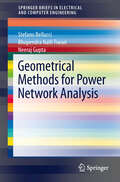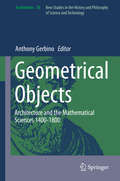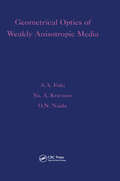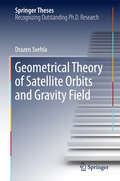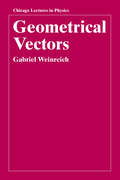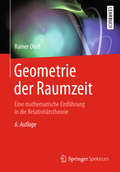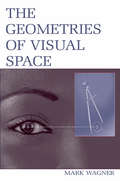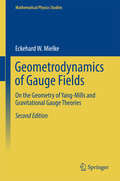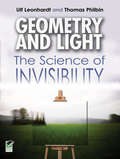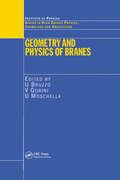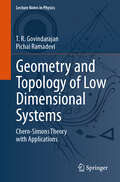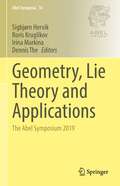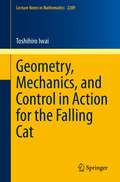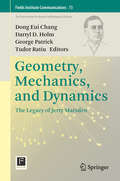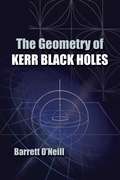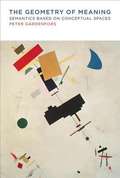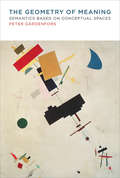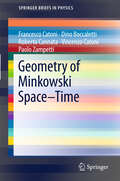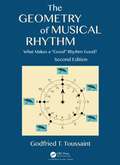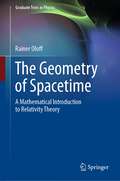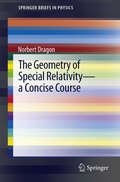- Table View
- List View
Geometrical Methods for Power Network Analysis
by Neeraj Gupta Bhupendra Nath Tiwari Stefano BellucciThis book is a short introduction to power system planning and operation using advanced geometrical methods. The approach is based on well-known insights and techniques developed in theoretical physics in the context of Riemannian manifolds. The proof of principle and robustness of this approach is examined in the context of the IEEE 5 bus system. This work addresses applied mathematicians, theoretical physicists and power engineers interested in novel mathematical approaches to power network theory.
Geometrical Objects
by Anthony GerbinoThis volume explores the mathematical character of architectural practice in diverse pre- and early modern contexts It takes an explicitly interdisciplinary approach, which unites scholarship in early modern architecture with recent work in the history of science, in particular, on the role of practice in the "scientific revolution" As a contribution to architectural history, the volume contextualizes design and construction in terms of contemporary mathematical knowledge, attendant forms of mathematical practice, and relevant social distinctions between the mathematical professions As a contribution to the history of science, the volume presents a series of micro-historical studies that highlight issues of process, materiality, and knowledge production in specific, situated, practical contexts Our approach sees the designer's studio, the stone-yard, the drawing floor, and construction site not merely as places where the architectural object takes shape, but where mathematical knowledge itself is deployed, exchanged, and amplified among various participants in the building process.
Geometrical Optics of Weakly Anisotropic Media
by AA FukiUntil recently, there was no effective method for describing waves in weakly anisotropic inhomogeneous media. The method of quasi-isotropic approximation (QIA) of geometrical optics was developed to overcome this problem. The QIA approach bridges the gap between geometrical optics of isotropic media (Rytov method) and that of anisotropic media (Courant-Lax approach). thus providing a complete picture of the geometrical optics of inhomogeneous media. The book explores recent developments in QIA and describes the application of the theory to different branches of wave physics, from plasma physics. quantum physics and ionospheric radio wave propagation to acoustics, optics and astrophysics. The authors present some modifications and generalisations of QIA equations, and look at electromagnetic waves and optical and acoustic effects in weakly anisotropic media, as well as geometrical optics of 3D inhomogeneous media. The book closes with some quantum mechanical analogies. This is an up-to-the minute exposition of the latest developments in an important new area, written by authors of outstanding international reputation. A rich source of both theoretical methods and practical applications, this book covers a wide range of problems of general physical significance and will be of interest to those working in optics, acoustics, electrical engineering, radio engineering and wave propagation through plasma.
Geometrical Theory of Satellite Orbits and Gravity Field (Springer Theses)
by Drazen SvehlaThis book on space geodesy presents pioneering geometrical approaches in the modelling of satellite orbits and gravity field of the Earth, based on the gravity field missions CHAMP, GRACE and GOCE in the LEO orbit. Geometrical approach is also extended to precise positioning in space using multi-GNSS constellations and space geodesy techniques in the realization of the terrestrial and celestial reference frame of the Earth. This book addresses major new developments that were taking place in space geodesy in the last decade, namely the availability of GPS receivers onboard LEO satellites, the multitude of the new GNSS satellite navigation systems, the huge improvement in the accuracy of satellite clocks and the revolution in the determination of the Earth's gravity field with dedicated satellite missions.
Geometrical Vectors (Chicago Lectures in Physics)
by Gabriel WeinreichEvery advanced undergraduate and graduate student of physics must master the concepts of vectors and vector analysis. Yet most books cover this topic by merely repeating the introductory-level treatment based on a limited algebraic or analytic view of the subject.Geometrical Vectors introduces a more sophisticated approach, which not only brings together many loose ends of the traditional treatment, but also leads directly into the practical use of vectors in general curvilinear coordinates by carefully separating those relationships which are topologically invariant from those which are not. Based on the essentially geometric nature of the subject, this approach builds consistently on students' prior knowledge and geometrical intuition. Written in an informal and personal style, Geometrical Vectors provides a handy guide for any student of vector analysis. Clear, carefully constructed line drawings illustrate key points in the text, and problem sets as well as physical examples are provided.
Geometrically Constructed Markov Chain Monte Carlo Study of Quantum Spin-phonon Complex Systems
by Hidemaro SuwaIn this thesis, novel Monte Carlo methods for precisely calculating the critical phenomena of the effectively frustrated quantum spin system are developed and applied to the critical phenomena of the spin-Peierls systems. Three significant methods are introduced for the first time: a new optimization algorithm of the Markov chain transition kernel based on the geometric weight-allocation approach, the extension of the worm (directed-loop) algorithm to nonconserved particles, and the combination with the level spectroscopy. Utilizing these methods, the phase diagram of the one-dimensional XXZ spin-Peierls system is elucidated. Furthermore, the multi-chain and two-dimensional spin-Peierls systems with interchain lattice interaction are investigated. The unbiased simulation shows that the interesting quantum phase transition between the 1D-like liquid phase and the macroscopically-degenerated dimer phase occurs on the fully-frustrated parameter line that separates the doubly-degenerated dimer phases in the two-dimensional phase diagram. The spin-phonon interaction in the spin-Peierls system introduces the spin frustration, which usually hinders the quantum Monte Carlo analysis, owing to the notorious negative sign problem. In this thesis, the author has succeeded in precisely calculating the critical phenomena of the effectively frustrated quantum spin system by means of the quantum Monte Carlo method without the negative sign.
Geometrie der Raumzeit: Eine mathematische Einführung in die Relativitätstheorie
by Rainer OloffDie Relativitätstheorie ist in ihren Kernaussagen nicht mehr umstritten, gilt aber noch immer als kompliziert und nur schwer verstehbar. Das liegt unter anderem an dem aufwendigen mathematischen Apparat, der schon zur Formulierung ihrer Ergebnisse und erst recht zum Nachvollziehen der Argumentation notwendig ist. In diesem Lehrbuch werden die mathematischen Grundlagen der Relativitätstheorie systematisch entwickelt, das ist die Differentialgeometrie auf Mannigfaltigkeiten einschließlich Differentiation und Integration. Die Spezielle Relativitätstheorie wird als Tensorrechnung auf den Tangentialräumen dargestellt. Die zentrale Aussage der Allgemeinen Relativitätstheorie ist die Einstein'sche Feldgleichung, die die Krümmung zur Materie in Beziehung setzt. Ausführlich werden die relativistischen Effekte im Sonnensystem einschließlich der Schwarzen Löcher behandelt. Dieser Text richtet sich an Studierende der Physik und der Mathematik und setzt nur Grundkenntnisse aus der klassischen Differential- und Integralrechnung und der Linearen Algebra voraus. Für die neue Auflage wurde das Buch durchgesehen und alle bekannt gewordenen Fehler korrigiert.
The Geometries of Visual Space
by Mark WagnerWhen most people think of space, they think of physical space. However, visual space concerns space as consciously experienced, and it is studied through subjective measures, such as asking people to use numbers to estimate perceived distances, areas, angles, or volumes. This book explores the mismatch between perception and physical reality, and describes the many factors that influence the perception of space including the meaning assigned to geometric concepts like distance, the judgment methods used to report the experience, the presence or absence of cues to depth, and the orientation of a stimulus with respect to point of view. The main theme of the text is that no single geometry describes visual space, but that the geometry of visual space depends upon the stimulus conditions and mental shifts in the subjective meaning of size and distance.In addition, The Geometries of Visual Space:*contains philosophical, mathematical, and psychophysical background material;*looks at synthetic approaches to space perception including work on hyperbolic, spherical, and Euclidean geometries;*presents a meta-analysis of studies that ask observers to directly estimate size, distance, area, angle, and volume;*looks at the size constancy literature in which observers are asked to adjust a comparison stimulus to match a variety of standards at different distances away;*discusses research that takes a multi-dimensional approach toward studying visual space; and*discusses how spatial experience is influenced by memory.While this book is primarily intended for scholars in perception, mathematical psychology, and psychophysics, it will also be accessible to a wider audience since it is written at a readable level. It will make a good graduate-level textbook on space perception.
Geometrodynamics of Gauge Fields: On the Geometry of Yang-Mills and Gravitational Gauge Theories (Mathematical Physics Studies)
by Eckehard W. MielkeThis monograph aims to provide a unified, geometrical foundation of gauge theories of elementary particle physics. The underlying geometrical structure is unfolded in a coordinate-free manner via the modern mathematical notions of fibre bundles and exterior forms. Topics such as the dynamics of Yang-Mills theories, instanton solutions and topological invariants are included. By transferring these concepts to local space-time symmetries, generalizations of Einstein's theory of gravity arise in a Riemann-Cartan space with curvature and torsion. It provides the framework in which the (broken) Poincaré gauge theory, the Rainich geometrization of the Einstein-Maxwell system, and higher-dimensional, non-abelian Kaluza-Klein theories are developed. Since the discovery of the Higgs boson, concepts of spontaneous symmetry breaking in gravity have come again into focus, and, in this revised edition, these will be exposed in geometric terms. Quantizing gravity remains an open issue: formulating it as a de Sitter type gauge theory in the spirit of Yang-Mills, some new progress in its topological form is presented. After symmetry breaking, Einstein’s standard general relativity with cosmological constant emerges as a classical background. The geometrical structure of BRST quantization with non-propagating topological ghosts is developed in some detail.
Geometry and Light: The Science of Invisibility (Dover Books on Physics)
by Ulf Leonhardt Thomas PhilbinThe science of invisibility combines two of physics' greatest concepts: Einstein's general relativity and Maxwell's principles of electromagnetism. Recent years have witnessed major breakthroughs in the area, and the authors of this volume -- Ulf Leonhardt and Thomas Philbin of Scotland's University of St. Andrews -- have been active in the transformation of invisibility from fiction into science. Their work on designing invisibility devices is based on modern metamaterials, inspired by Fermat's principle, analogies between mechanics and optics, and the geometry of curved space. Suitable for graduate students and advanced undergraduates of engineering, physics, or mathematics, and scientific researchers of all types, this is the first authoritative textbook on invisibility and the science behind it. The book is two books in one: it introduces the mathematical foundations -- differential geometry -- for physicists and engineers, and it shows how concepts from general relativity become practically useful in electrical and optical engineering, not only for invisibility but also for perfect imaging and other fascinating topics. More than one hundred full-color illustrations and exercises with solutions complement the text.
Geometry and Physics of Branes
by Ugo BruzzoBranes are solitonic configurations of a string theory that are represented by extended objects in a higher-dimensional space-time. They are essential for a comprehension of the non-perturbative aspects of string theory, in particular, in connection with string dualities. From the mathematical viewpoint, branes are related to several important theo
Geometry and Topology of Low Dimensional Systems: Chern-Simons Theory with Applications (Lecture Notes in Physics #1027)
by T. R. Govindarajan Pichai RamadeviThis book introduces the field of topology, a branch of mathematics that explores the properties of geometric space, with a focus on low-dimensional systems. The authors discuss applications in various areas of physics. The first chapters of the book cover the formal aspects of topology, including classes, homotopic groups, metric spaces, and Riemannian and pseudo-Riemannian geometry. These topics are essential for understanding the theoretical concepts and notations used in the next chapters of the book. The applications encompass defects in crystalline structures, space topology, spin statistics, Braid group, Chern-Simons field theory, and 3D gravity, among others. This self-contained book provides all the necessary additional material for both physics and mathematics students. The presentation is enriched with examples and exercises, making it accessible for readers to grasp the concepts with ease. The authors adopt a pedagogical approach, posing many unsolved questions in simple situations that can serve as challenging projects for students. Suitable for a one-semester postgraduate level course, this text is ideal for teaching purposes.
Geometry, Lie Theory and Applications: The Abel Symposium 2019 (Abel Symposia #16)
by Sigbjørn Hervik Boris Kruglikov Irina Markina Dennis TheThis book consists of contributions from the participants of the Abel Symposium 2019 held in Ålesund, Norway. It was centered about applications of the ideas of symmetry and invariance, including equivalence and deformation theory of geometric structures, classification of differential invariants and invariant differential operators, integrability analysis of equations of mathematical physics, progress in parabolic geometry and mathematical aspects of general relativity.The chapters are written by leading international researchers, and consist of both survey and research articles. The book gives the reader an insight into the current research in differential geometry and Lie theory, as well as applications of these topics, in particular to general relativity and string theory.
Geometry, Mechanics, and Control in Action for the Falling Cat (Lecture Notes in Mathematics #2289)
by Toshihiro IwaiThe falling cat is an interesting theme to pursue, in which geometry, mechanics, and control are in action together. As is well known, cats can almost always land on their feet when tossed into the air in an upside-down attitude. If cats are not given a non-vanishing angular momentum at an initial instant, they cannot rotate during their motion, and the motion they can make in the air is vibration only. However, cats accomplish a half turn without rotation when landing on their feet. In order to solve this apparent mystery, one needs to thoroughly understand rotations and vibrations. The connection theory in differential geometry can provide rigorous definitions of rotation and vibration for many-body systems. Deformable bodies of cats are not easy to treat mechanically. A feasible way to approach the question of the falling cat is to start with many-body systems and then proceed to rigid bodies and, further, to jointed rigid bodies, which can approximate the body of a cat. In this book, the connection theory is applied first to a many-body system to show that vibrational motions of the many-body system can result in rotations without performing rotational motions and then to the cat model consisting of jointed rigid bodies. On the basis of this geometric setting, mechanics of many-body systems and of jointed rigid bodies must be set up. In order to take into account the fact that cats can deform their bodies, three torque inputs which may give a twist to the cat model are applied as control inputs under the condition of the vanishing angular momentum. Then, a control is designed according to the port-controlled Hamiltonian method for the model cat to perform a half turn and to halt the motion upon landing. The book also gives a brief review of control systems through simple examples to explain the role of control inputs.
Geometry, Mechanics, and Dynamics
by Dong Eui Chang Darryl D. Holm George Patrick Tudor RatiuThis book illustrates the broad range of Jerry Marsden's mathematical legacy in areas of geometry, mechanics, and dynamics, from very pure mathematics to very applied, but always with a geometric perspective. Each contribution develops its material from the viewpoint of geometric mechanics beginning at the very foundations, introducing readers to modern issues via illustrations in a wide range of topics. The twenty refereed papers contained in this volume are based on lectures and research performed during the month of July 2012 at the Fields Institute for Research in Mathematical Sciences, in a program in honor of Marsden's legacy. The unified treatment of the wide breadth of topics treated in this book will be of interest to both experts and novices in geometric mechanics. Experts will recognize applications of their own familiar concepts and methods in a wide variety of fields, some of which they may never have approached from a geometric viewpoint. Novices may choose topics that interest them among the various fields and learn about geometric approaches and perspectives toward those topics that will be new for them as well.
The Geometry of Celestial Mechanics
by Hansjörg GeigesCelestial mechanics is the branch of mathematical astronomy devoted to studying the motions of celestial bodies subject to the Newtonian law of gravitation. This mathematical introductory textbook reveals that even the most basic question in celestial mechanics, the Kepler problem, leads to a cornucopia of geometric concepts: conformal and projective transformations, spherical and hyperbolic geometry, notions of curvature, and the topology of geodesic flows. For advanced undergraduate and beginning graduate students, this book explores the geometric concepts underlying celestial mechanics and is an ideal companion for introductory courses. The focus on the history of geometric ideas makes it perfect supplementary reading for students in elementary geometry and topology. Numerous exercises, historical notes and an extensive bibliography provide all the contextual information required to gain a solid grounding in celestial mechanics.
Geometry of Crystals, Polycrystals, and Phase Transformations
by Harshad K. Bhadeshia<p>Organized into a two-part structure aimed at readers of differing experience levels, Geometry of Crystals, Polycrystals, and Phase Transformations is accessible to both newcomers and advanced researchers within the field of crystallography. The first part of the text covers what any reader in the material sciences, physics, chemistry, earth sciences and natural sciences in general should know about crystallography. It is intentionally concise and covers sufficient material to form a firm foundation. <p>The second part is aimed at researchers and discusses phase transformations, deformations, and interface crystallography in depth. The phase transformations are limited to those dominated by crystallography. The entire book contains worked examples and uniquely deals not just with crystals but aggregates of crystals and solid-state transformations between crystals.</p>
The Geometry of Kerr Black Holes (Dover Books on Physics)
by Barrett O'NeillThis unique monograph by a noted UCLA professor examines in detail the mathematics of Kerr black holes, which possess the properties of mass and angular momentum but carry no electrical charge. Suitable for advanced undergraduates and graduate students of mathematics, physics, and astronomy as well as professional physicists, the self-contained treatment constitutes an introduction to modern techniques in differential geometry. The text begins with a substantial chapter offering background on the mathematics needed for the rest of the book. Subsequent chapters emphasize physical interpretations of geometric properties such as curvature, geodesics, isometries, totally geodesic submanifolds, and topological structure. Further investigations cover relativistic concepts such as causality, Petrov type, optical scalars, and the Goldberg-Sachs theorem. Four helpful appendixes supplement the text.
The Geometry of Meaning
by Peter GärdenforsIn The Geometry of Meaning, Peter Gärdenfors proposes a theory of semantics that bridges cognitive science and linguistics and shows how theories of cognitive processes, in particular concept formation, can be exploited in a general semantic model. He argues that our minds organize the information involved in communicative acts in a format that can be modeled in geometric or topological terms -- in what he terms conceptual spaces, extending the theory he presented in an earlier book by that name. Many semantic theories consider the meanings of words as relatively stable and independent of the communicative context. Gärdenfors focuses instead on how various forms of communication establish a system of meanings that becomes shared between interlocutors. He argues that these "meetings of mind" depend on the underlying geometric structures, and that these structures facilitate language learning. Turning to lexical semantics, Gärdenfors argues that a unified theory of word meaning can be developed by using conceptual spaces. He shows that the meaning of different word classes can be given a cognitive grounding, and offers semantic analyses of nouns, adjectives, verbs, and prepositions. He also presents models of how the meanings of words are composed to form new meanings and of the basic semantic role of sentences. Finally, he considers the future implications of his theory for robot semantics and the Semantic Web.
The Geometry of Meaning: Semantics Based on Conceptual Spaces
by Peter GardenforsA novel cognitive theory of semantics that proposes that the meanings of words can be described in terms of geometric structures. In The Geometry of Meaning, Peter Gärdenfors proposes a theory of semantics that bridges cognitive science and linguistics and shows how theories of cognitive processes, in particular concept formation, can be exploited in a general semantic model. He argues that our minds organize the information involved in communicative acts in a format that can be modeled in geometric or topological terms—in what he terms conceptual spaces, extending the theory he presented in an earlier book by that name. Many semantic theories consider the meanings of words as relatively stable and independent of the communicative context. Gärdenfors focuses instead on how various forms of communication establish a system of meanings that becomes shared between interlocutors. He argues that these “meetings of mind” depend on the underlying geometric structures, and that these structures facilitate language learning. Turning to lexical semantics, Gärdenfors argues that a unified theory of word meaning can be developed by using conceptual spaces. He shows that the meaning of different word classes can be given a cognitive grounding, and offers semantic analyses of nouns, adjectives, verbs, and prepositions. He also presents models of how the meanings of words are composed to form new meanings and of the basic semantic role of sentences. Finally, he considers the future implications of his theory for robot semantics and the Semantic Web.
Geometry of Minkowski Space-Time
by Paolo Zampetti Vincenzo Catoni Roberto Cannata Francesco Catoni Dino BoccalettiThis book provides an original introduction to the geometry of Minkowski space-time. A hundred years after the space-time formulation of special relativity by Hermann Minkowski, it is shown that the kinematical consequences of special relativity are merely a manifestation of space-time geometry. The book is written with the intention of providing students (and teachers) of the first years of University courses with a tool which is easy to be applied and allows the solution of any problem of relativistic kinematics at the same time. The book treats in a rigorous way, but using a non-sophisticated mathematics, the Kinematics of Special Relativity. As an example, the famous "Twin Paradox" is completely solved for all kinds of motions. The novelty of the presentation in this book consists in the extensive use of hyperbolic numbers, the simplest extension of complex numbers, for a complete formalization of the kinematics in the Minkowski space-time. Moreover, from this formalization the understanding of gravity comes as a manifestation of curvature of space-time, suggesting new research fields.
The Geometry of Musical Rhythm: What Makes a "Good" Rhythm Good?, Second Edition
by Godfried T. ToussaintThe original edition of The Geometry of Musical Rhythm was the first book to provide a systematic and accessible computational geometric analysis of the musical rhythms of the world. It explained how the study of the mathematical properties of musical rhythm generates common mathematical problems that arise in a variety of seemingly disparate fields. The book also introduced the distance approach to phylogenetic analysis and illustrated its application to the study of musical rhythm. The new edition retains all of this, while also adding 100 pages, 93 figures, 225 new references, and six new chapters covering topics such as meter and metric complexity, rhythmic grouping, expressive timbre and timing in rhythmic performance, and evolution phylogenetic analysis of ancient Greek paeonic rhythms. In addition, further context is provided to give the reader a fuller and richer insight into the historical connections between music and mathematics.
Geometry of Quantum States: An Introduction to Quantum Entanglement
by Ingemar Bengtsson Karol ŻyczkowskiQuantum information theory is a branch of science at the frontier of physics, mathematics, and information science, and offers a variety of solutions that are impossible using classical theory. This book provides a detailed introduction to the key concepts used in processing quantum information and reveals that quantum mechanics is a generalisation of classical probability theory. The second edition contains new sections and entirely new chapters: the hot topic of multipartite entanglement; in-depth discussion of the discrete structures in finite dimensional Hilbert space, including unitary operator bases, mutually unbiased bases, symmetric informationally complete generalized measurements, discrete Wigner function, and unitary designs; the Gleason and Kochen-Specker theorems; the proof of the Lieb conjecture; the measure concentration phenomenon; and the Hastings' non-additivity theorem. This richly-illustrated book will be useful to a broad audience of graduates and researchers interested in quantum information theory. Exercises follow each chapter, with hints and answers supplied.
The Geometry of Spacetime: A Mathematical Introduction to Relativity Theory (Graduate Texts in Physics)
by Rainer OloffThis book systematically develops the mathematical foundations of the theory of relativity and links them to physical relations. For this purpose, differential geometry on manifolds is introduced first, including differentiation and integration, and special relativity is presented as tensor calculus on tangential spaces. Using Einstein's field equations relating curvature to matter, the relativistic effects in the solar system including black holes are discussed in detail. The text is aimed at students of physics and mathematics and assumes only basic knowledge of classical differential and integral calculus and linear algebra.
The Geometry of Special Relativity - a Concise Course
by Norbert DragonIn this concise primer it is shown that, with simple diagrams, the phenomena of time dilatation, length contraction and Lorentz transformations can be deduced from the fact that in a vacuum one cannot distinguish physically straight and uniform motion from rest, and that the speed of light does not depend on the speed of either the source or the observer. The text proceeds to derive the important results of relativistic physics and to resolve its apparent paradoxes. A short introduction into the covariant formulation of electrodynamics is also given. This publication addresses, in particular, students of physics and mathematics in their final undergraduate year.
